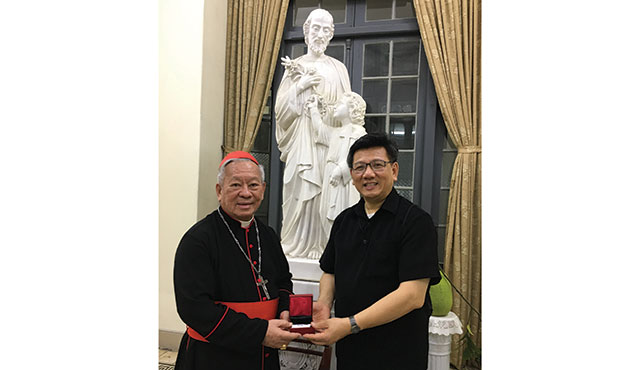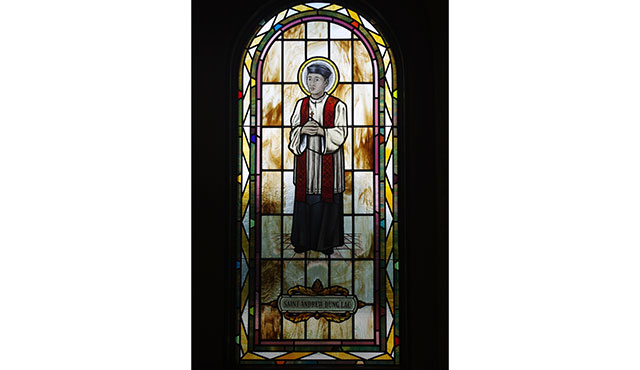Their words echo across generations. Their legacies inspire millions.
Catholic saints lived with discipline and dedication, working to ensure their actions and words aligned with God’s will.
They are heroes of the Catholic faith, serving as examples of how to live a holy life.
Physical objects connected to Catholic saints—bones, blood and clothing—are considered sacred relics and venerated by the faithful.
Christ Cathedral’s stone altar will be home to the relics of martyrs and saints who reflect the diversity of the Diocese of Orange.
“The relics of the saints which will be enclosed beneath the altar in Christ Cathedral connect us directly with the witness and life of the early martyrs of the Church whose remains were placed in the Roman Catacombs,” said Most Rev. Kevin W. Vann, Bishop of Orange. “The relics connected with the altar teach us of the Communion of Saints, our worship and prayer, and the witness we all need to give daily to Christ in our world.”
The relics are from saints and martyrs from across history, and across the globe, who lived and died for their faith.
“Christ Cathedral is a beacon of Christ’s light,” said Msgr. Stephen Doktorczyk, vicar general of the Diocese of Orange, who helped bring the relics of the North American Martyrs to the Diocese. “Having relics available for veneration brings to the present an ancient tradition that traces its roots back to the time of Elisha, 850 years before Christ.”
The tradition of placing relics in the altars of Catholic churches and cathedrals is solemn and sacred.
“We look to these holy men and women as examples of how to live our faith and they can inspire us to live holy lives, as they do for so many people today,” said Lesa Truxaw, director of the Office for Worship for the Diocese of Orange.
Relics are classified in three categories. A first-class relic is a part of the saint’s body, such as a bone. A second-class relic is a piece of the saint’s clothing or something used by the saint, while a third-class relic is an object that has been touched by the saint or by a first-class relic.
The relics of Christ Cathedral are first class, and come from as far away as Vietnam and South Korea. They have been authenticated by a competent authority, including leaders at the dioceses and religious orders from where they came.
At Christ Cathedral, each of the relics will be placed in a cedar box that will go inside the altar’s bronze reliquary, which is embellished with precious stones. The reliquary is enclosed and fixed into place in the base of the altar.
Before they were interred in the cathedral’s 14,000-pound altar, the relics were brought on a pilgrimage to parishes in the Diocese. Solemn evening prayer will be celebrated followed by an extended vigil to venerate the relics the night before the cathedral’s dedication.
The relics from Vietnamese, Korean, North American and Mexican martyrs and saints symbolize the diversity of the Catholic community in Orange County. By venerating the relics and the lives of saints, Catholics in Orange County can grow closer to their faith, and each other.
“When we began to look for relics for Christ Cathedral we knew we wanted a representation of who we are as a Diocese,” Truxaw said. “We can learn a lot about our faith through other cultures. We can come to understand the importance of our faith through those who see life through a different lens.”
St. Pope John Paul II
Among the most influential figures of the 20th century, Karol Józef Wojtyła was ordained a priest in 1946 and elected pope by Papal conclave on October 16, 1978, becoming the first non-Italian Catholic pope in more than 400 years. He adopted the name Pope John Paul II in honor of his predecessor, Pope John Paul I, who died 33 days after being elected pope. Considered among the Catholic Church’s most transformative figures, Pope John Paul II visited 129 countries during his pontificate, spreading a message of faith, peace and love. He was an advocate for human rights and inspired tens of millions to find the Lord’s call. St. Pope John Paul II was canonized on April 27, 2014 by Pope Francis.
St. Junípero Serra
Few figures in western Catholicism are more known than Junípero Serra, the Franciscan friar who traveled across Mexico and Alta California in the 18th century on a legendary mission to share his Catholic faith. The Diocese of Orange’s origins—along with the roots of Catholicism in Orange County, California and the United States—can be traced to Serra.
The Spanish-born Serra founded the first missions in the California mission system, including Mission San Juan Capistrano in 1776.
“St. Serra brought faith to our state and specifically here in our county,” Truxaw said.
St. Serra was canonized by Pope Francis in 2015, and his relic interred at Christ Cathedral is a bone fragment that was donated to the Diocese.
St. Andrew Dũng-Lạc
St. Andrew Dũng-Lạc was a Vietnamese priest in the 19th century who was persecuted and killed for his spiritual beliefs. He was among 117 Catholics martyred in Vietnam between 1820 and 1862.
The relic—a bone from the saint’s hand—was gifted to the Diocese of Orange by Pierre Cardinal Nguyên Văn Nhon of the Archdiocese of Hanoi. The remains of St. Andrew Dũng-Lạc, including his skull, are on display behind glass at St. Joseph’s Cathedral in Hanoi.
Rev. John Francis Vu, Catholic chaplain at the University of California, Irvine, travelled to Hanoi in November to accept the relic from Cardinal Nguyen. Cardinal Nguyen handed Rev. Vu the relic at the cardinal’s private residence near the cathedral. Early the next morning, Cardinal Nguyen received word that Pope Francis accepted the resignation the cardinal had submitted 5 ½ years earlier, and that his retirement would be effective at noon Rome time that very day. Gifting the relic to the Diocese of Orange would be Cardinal Nguyen’s final official act before retirement.
Orange County is home to the largest Vietnamese population outside of Vietnam and the Archdiocese of Hanoi is the sister diocese of the Diocese of Orange.
“This relic symbolizes the strong bond between our Catholic community in Orange County, and the Catholic community in Vietnam,” Bishop Vann said.
St. Andrew Dũng-Lạc was canonized in June 1988 by Pope John Paul II.
St. Andrew Kim Taegon
The first native-born Korean priest, St. Andrew Kim Taegon is among the most prominent saints in east Asia. He was among thousands of Korean Catholics who were persecuted and killed in the 19th century for following their faith. He was killed in 1846, at the age of 25, on the banks of the Han River near Seoul.
St. Andrew Kim Taegon was canonized by Pope John Paul II in May 1984, along with 102 Korean martyrs.
A delegation from the Archdiocese of Seoul travelled to Orange County in December, delivering the relic of St. Andrew Kim Taegon to Auxiliary Bishop Tim Freyer, who accepted it on behalf of Bishop Vann and the Diocese of Orange. A member of the four-person delegation stayed with the relic at all times while en route.
The relic is a bone from the upper cervical vertebrae.
St. Andrew Kim Taegon is an influential figure for Korean Catholics, and his portrait is often prominently displayed in churches serving Korean-American communities.
“Having a relic of St. Andrew inside the cathedral serves as a rallying point for the Korean Catholic community, not only those from the Diocese of Orange, but from all of Southern California,” said Rev. Eugene Lee, who served as a liaison between the Diocese of Orange and the Archdiocese of Seoul to bring a relic to Christ Cathedral.
North American Martyrs
St. John de Brébeuf, St. Charles Garnier and St. Gabriel Lalemant were French Jesuit priests who lived and worked among the Native American tribes in Canada and upstate New York in the 17th century. They were killed during conflict between the warring tribes of the Iroquois Confederacy. They were canonized as martyrs by Pope Pius XI in 1930. Along with 5 other Jesuit missionaries killed in Canada and upstate New York between 1642 and 1649, they are known collectively as the North American Martyrs.
Their relics were obtained by Msgr. Stephen Doktorczyk, vicar general for the Diocese of Orange, who corresponded with officials from the Jesuits USA Northeast Province, based in New York City.
“The diocese is grateful for the kindness and cooperation of the USA Northeast Province of the Society of Jesus, including Father John J. Cecero, S.J., Provincial, in responding positively to the Diocese’s request for relics,” Doktorczyk said.
St. Rafael Guízar y Valencia
St. Rafael Guízar y Valencia was a Mexican Catholic bishop who lived in the late 19th and early 20th century. He was known for caring for the sick and was wounded during the Mexican Revolution.
During the revolution, he continued his work as a priest despite facing intense persecution and was forced to flee to Cuba. After the revolution he returned to Mexico, and continued his ministry to the poor and infirmed until his death in 1938.
St. Rafael Guízar y Valencia was canonized in October 2015 by Pope Benedict XVI.
The relic was gifted to the Diocese and Bishop Vann by Rev. Al Baca.
St. Justino Orona Madrigal
Born in April 1877 in Jalisco, Mexico, Justino was the son of an extremely poor family. He completed his initial studies at Zapotlán before entering Guadalajara’s seminary. After his ordination, he served as a parish priest at Poncitlán, Encarnación, Jalisco, and Cuquío. Despite an atmosphere of anticlericalism and religious indifference, he was an exemplary priest. While he was pastor of Cuquío, he founded the Congregation of Claretian Brothers of the Sacred Heart to care for orphans and poor children. When the persecution intensified, he and his associate, (St.) Atilano Cruz, decided to remain with their flock despite the danger, but hid themselves on the nearby ranch of Las Cruces with Justino’s brother José María and Toribio Ayala. Federal forces arrived there at dawn on July 1, 1928 with the mayor of Cuquío. Justino opened the door, shouted “Viva Cristo Rey!” and was shot. St. Justino Orona Madrigal was canonized on May 21, 2000 by Pope John Paul II.
St. Atilano Cruz Alvarado
Born on October 5, 1901 in the tiny village of Ahuetita de Abajo in Jalisco, Mexico, Atilano herded cattle until his native parents sent him to the town of Teocaltiche for schooling. He began his seminary studies there, continued in Guadalajara, and was ordained at the height of the religious persecution when it was a felony to be a priest. Thereafter he was sent to replace St. Toribio Romo, another martyr, in the parish of Cuquío, Jalisco, but hidden on the ranch of Ponciano Jiménez called Las Cruces. Eleven months after his ordination, 50 soldiers arrived in the dead of night on July 1, 1928 with civilian authorities. When Atilano heard them killing his superior, Justino Orona, he knelt in prayer to await them. His naked body, deposited by the soldiers in the city square, was retrieved and buried by the faithful at the parish church of Cuquío, where it is venerated today. He was canonized on May 21, 2000 by Pope John Paul II.






